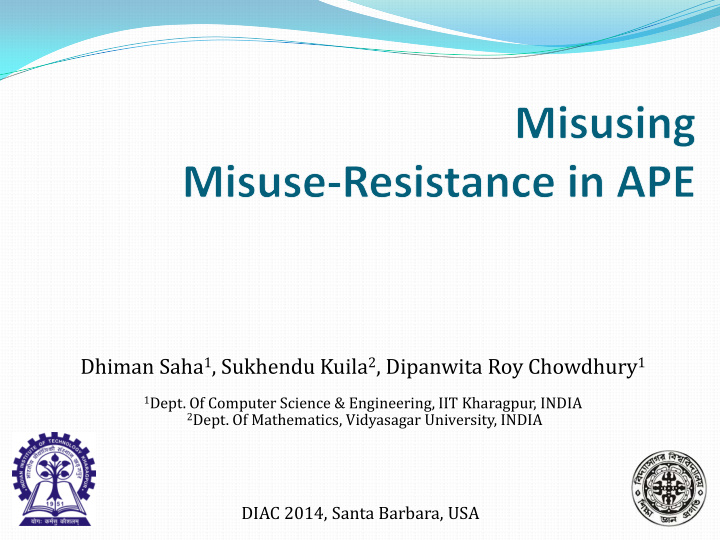



Dhiman Saha 1 , Sukhendu Kuila 2 , Dipanwita Roy Chowdhury 1 1 Dept. Of Computer Science & Engineering, IIT Kharagpur, INDIA 2 Dept. Of Mathematics, Vidyasagar University, INDIA DIAC 2014, Santa Barbara, USA
Nonce-based Encryption Formalized by Rogaway Primary Condition Uniqueness of the nonce in every instantiation of the cipher Interesting Consequence Automatic protection from Differential Fault Analysis (DFA) DFA assumption Ability to induce faults in the intermediate state of the cipher while replaying the encryption with the same plaintext. No longer holds due to introduction of nonce
Misuse-Resistance A desirable property for authenticated ciphers. Avoids maintaining a nonce-generator Suited for resource constrained environments Addressed in CAESAR selection portfolio However, there is some collateral damage. Nonce assumption no longer holds Opens up the ciphers for DFA This work explores this idea to mount efficient DFA on misuse- resistant AE scheme APE
APE Authenticated Permutation-based Encryption – APE Introduced first in FSE 2014 First misuse-resistant permutation-based AE scheme Inspired from SPONGE Targeted for lightweight environments Basically a mode of operation Can be instantiated with permutations of hashes like SPONGENT/QUARK/PHOTON Reintroduced in CAESAR Along with HANUMAN & GIBBON Part of PRIMATEs family of authenticated ciphers Now with new indigenous permutation called PRIMATE
The PRIMATE Permutation Internal permutation for APE/HANUMAN/GIBBON Inspired from FIDES authenticated cipher Structurally follows AES round function Has two variants PRIMATE-80/120 Internal state realized as (5 x 8) / (7 x 8) five-bit elements Component Transformations SubBytes ShiftRows MixColumns Round constant addition
PRIMATE-APE N[·] – Nonce block A[·] – Associated data block M[·]– message block K – Key (160 bit for APE-80) The IVs are predefined and vary according to the nature of the length of message and associated data. This work uses APE-80 (can be extended to APE-120)
Misusing Misuse-Resistance Concept of faulty collisions : Not a real collision Attacker induces a fault in the state of the cipher so that two different plaintexts produce the same tag. Idea : To find faulty collisions Feasible due to misuse-resistance Observation : APE is misuse-resistant up to a common prefix. Common prefix implication: Plaintexts can be of the following form: M1 = x 0 || x 1 || x 2 || … || x i || … || x w M2 = x 0 || x 1 || x 2 || … || x’ i || … || x w
A Faulty Collision Exploits : Misuse-resistance + Online nature Induce random word fault in (i-1) th ciphertext output Observe faulty (i-1) th output & manipulate i th message input
Implications of a Faulty Collision Ability to replay the encryption Recall This is one of the fundamental requirements to mount differential fault analysis attacks Next, we explore the prospect of DFA in the presence of faulty collisions Fault model assumed is random word fault Recall : word in case of APE is a 5-bit vector
Fault Induction Fault induced at the input of 10 th round of the final iteration of APE Next study the fault diffusion in the differential state in the remaining rounds
Fault Diffusion Observe: Exactly 3 specific unaffected columns at the start of r th round due to diagonal word fault at the start of (r-2) th round. Helps to identify fault source diagonal by observing differential state Exploits the non-square nature of state matrix
Diagonal Fault Analysis Advanced differential fault attack Introduced in 2009, specially suited for AES-like constructions Has been highlighted in the book Fault Analysis in Cryptography as one of the most efficient DFA on AES Available on Eprint archive - https://eprint.iacr.org/2009/581 Exploits equivalence of fault induced in the same diagonal of the state matrix Can be applied on APE But not directly Last round MixColumn inclusion - major deviation from AES Makes classical diagonal attack inefficient Need some adaptation Focus on recovering the state instead of the key
The Fault Invariant The diagonal principle : Equivalence of faults limited to a diagonal The relation matrix is governed by MixColumns
EscApe : Diagonal Fault Analysis of APE Inbound phase Invert the differential state (computed from correct and faulty output) to reach up to state after last round SubBytes. Use unaffected columns to identify source fault diagonal and load appropriate relation matrix Solve equations involving fault invariant to generate hyper-state Hyper-State is a special structure where every element is a set of candidates computed after equation solving Helps capture the notion of candidate states for the correct state
EscApe (contd.) The Outbound phase Apply ShiftRows to Hyper-state Compute Kernel (Refer paper for details) Apply MixColumns to Kernel Reduce message space by verifying candidates against last ciphertext block Exploits the availability of last ciphertext block Simulations confirm large-scale reduction due to this Reduced message space directly corresponds to reduced key space.
EscApe :The Final Picture
Results In the presence of faulty collision: Fault Count Fault Type Avg. Final Key Space 1 Random word 2 80 fault at 2 2 25 the start of 10 th 3 2 5 round in the last iteration of 4 1 APE
Epilogue Shown how the desirable property of misuse-resistance becomes the gateway for DFA First fault analysis of SPONGE when used in the context of authenticated encryption EscApe : efficient diagonal attack on APE 2 faults lead to a practical attack, 4 give the unique key Removal of final truncation of FIDES in APE makes EscApe highly efficient Finally, its evident that Misuse-resistance, Design of underlying permutation and Choice of mode of operation can all contribute to the susceptibility of authenticated ciphers to fault attacks
Thank You Please forward any queries to crypto@dhimans.in Full version of the paper : http://de.ci.phe.red or, CAESAR mailing list
Recommend
More recommend